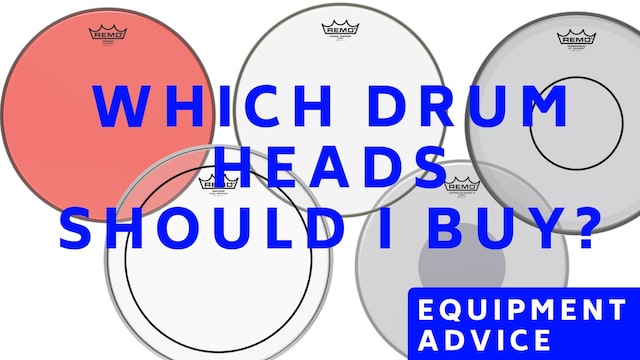Which drum heads Should I Buy?

Many people ask, “Which drum heads Should I Buy?” because there are so many options and it’s difficult to know which drum head will achieve the right sound for your needs.
Although originally drumheads were made from calf heads (find out more here if interested) since the 1950s they are made from plastics that don’t get affected by atmospheric conditions like the calf heads did.
And today we are presented with a huge choice of different heads, which can seem overwhelming at first. When looking to buy heads you might feel stifled by the choices so I want to break it down and keep it simple.
Mot of us will need one of two types of head in general:
- Single ply
- Double ply
So which do you need?
That depends on the type of music you play and your personal preference. Double ply heads are thicker and therefore more durable. They last longer which might suit a heavy hitter who wears heads out quickly. The downside is that they resonate less and therefore have less tone.
If you want a more defined note then the single ply might be preferable.
A Remo Pinstripe is a popular double ply option whilst the Remo Ambassador is the industry standard single ply head. Remo Emperors are a good mid point and are often my choice for tom heads.
It is quite common that you have something like a single ply Ambassador on the toms but you want something more durable for your snare drum. In that case something like a Remo Controlled Sound might meet your needs with its centre dot that offers more durability.
Whilst I play Remo heads, it is fair to say that all the major brands offer high quality heads and offer the full range of heads for each application.
When it comes to the bass drum you might like something such as the Remo Powerstroke P3 Smooth White which also comes with an impact patch for the point that the beater connects with the head. This adds extra durability. You can buy these separately if your bass drum head doesn’t come with one.
Another option is the Remo Powerstroke Pro which comes with an external piece of foam fitted to reduce overtones even further. The Evans Emad offers a similar design.
Another head that needs specialist attention is the bottom snare drum head. This needs to be very thin so that the snare wires can vibrate freely. If you use a top (batter) head then the snare wires cannot respond effectively. The Remo Diplomat Hazy Snare Side is a good example of this.
As well as Remo you might like to look at Evans or Aquarian.
Here are links to the heads mentioned above
- Remo Ambassador 1 ply 10 mil
- Remo Emperor 2 plies of 7 mil
- Remo Pinstripe 2 plies 7 mil with overtone reducing agent between the plies.
- Remo Controlled Sound 1 ply 12 mil with 5 mil black dot
- Remo Diplomat Hazy Snare Side 1 ply 2 mil
- Remo Powerstroke p3 bass drum 1 ply 10 mil plus a 10 mil inlay ring to control overtones
- Remo Powerstroke Pro 1 ply 10 mil with external foam ring
NB: A mil refers to one-thousandth of an inch and not one millimetre. That would mean a 10mil ply was 10 millimetres thick and that would be crazy!
Coated or clear?
Once you have chosen the head type you next need to decide on whether you want coated or clear heads. Coated heads are most commonly white and clear heads are transparent.
You might be swayed by the aesthetics of each option but the coating actually provides a different sound. Quite simply, the clear heads are brighter and more resonant whilst the coated heads are warmer and more focussed.
So if you want a really modern, more resonant, ringy sound then get clear heads. If you want the overtones more controlled for a deader sound then try coated.
I use both but most commonly I opt for coated.
There is no wrong or right here. In fact there is no wrong or right with any of the heads mentioned above.
It is important that you try different options and learn which one you like, what type of sounds you can achieve with different heads and gradually build your knowledge through experience.
Hopefully you can now answer the question, “Which drum heads should I buy,” or at least know what to start thinking about.
If you want to get the best sound possible from your drums then you ned to learn how to tune and maintain them properly. In which case check out the drum tuning guide which goes deep into each drum as well as the drum kite as a whole.




